Complete Solutions to REVIEW QUESTIONS of chapter EXCRETORY SYSTEM of Class 10 book with complete answers and questions
| Class 10 | BIOLOGY |
| Chapter | EXCRETORY SYSTEM |
| EVERGREEN PUBLICATION | REVIEW QUESTIONS |
| Number Of Questions | 69 |
| Academic Year | 2023-24 |
Define the Glomerulus
View SolutionDefine the Nephritis
View SolutionDefine the Osmoregulation
View SolutionDefine the Ultrafiltration
View SolutionDifferentiate between : Excretion and Egestion
View SolutionDifferentiate between : Ammonotelism and Aminotelism
View SolutionDifferentiate between : Ureter and Urethra
View SolutionDifferentiate between : Renal papilla and Renal pelvis
View SolutionDifferentiate between : Afferent and Efferent arterioles
View SolutionDescribe in brief : Ultrafiltration
View SolutionDescribe in brief : Selective reabsorption
View SolutionDescribe in brief : Tubular secretion
View SolutionDescribe in brief : Osmoregulation
View SolutionDiscuss various functions of kidneys.
View SolutionName the Some common disorders of kidneys in man.
View SolutionName the Various excretory products in man.
View SolutionName the The organ where urea is produced.
View SolutionName the The pigment providing colour to urine.
View SolutionName the knot like mass of blood capillaries inside the Bowman's capsule.
View SolutionName the The process of removal of nitrogenous wastes from the body.
View SolutionThe diagram given below represents a mammalian kidney tubule (nephron) and its blood supply. Parts indicated by the guidelines 1 to 8 are as follows:

1. U-shaped loop of Henle,
2. Proximal convoluted tubule with blood capillaries,
3. Bowman's capsule,
4. Afferent arteriole from renal artery,
5. Glomerulus,
6. Venule to renal vein,
7. Collecting tubule.
8. Distal convoluted tubule with blood capillaries.
Study the diagram and answer the following questions in each case :
Where does ultrafiltration take place ?
View SolutionThe diagram given below represents a mammalian kidney tubule (nephron) and its blood supply. Parts indicated by the guidelines 1 to 8 are as follows:

1. U-shaped loop of Henle,
2. Proximal convoluted tubule with blood capillaries,
3. Bowman's capsule,
4. Afferent arteriole from renal artery,
5. Glomerulus,
6. Venule to renal vein,
7. Collecting tubule.
8. Distal convoluted tubule with blood capillaries.
Study the diagram and answer the following questions in each case :
Which structure contains the lowest concentration of urea ?
View SolutionThe diagram given below represents a mammalian kidney tubule (nephron) and its blood supply. Parts indicated by the guidelines 1 to 8 are as follows:

1. U-shaped loop of Henle,
2. Proximal convoluted tubule with blood capillaries,
3. Bowman's capsule,
4. Afferent arteriole from renal artery,
5. Glomerulus,
6. Venule to renal vein,
7. Collecting tubule.
8. Distal convoluted tubule with blood capillaries.
Study the diagram and answer the following questions in each case :
Which structure contains the highest concentration of urea ?
View SolutionThe diagram given below represents a mammalian kidney tubule (nephron) and its blood supply. Parts indicated by the guidelines 1 to 8 are as follows:

1. U-shaped loop of Henle,
2. Proximal convoluted tubule with blood capillaries,
3. Bowman's capsule,
4. Afferent arteriole from renal artery,
5. Glomerulus,
6. Venule to renal vein,
7. Collecting tubule.
8. Distal convoluted tubule with blood capillaries.
Study the diagram and answer the following questions in each case :
Which structure (normally) contains the lowest concentration of glucose ?
View SolutionThe diagram given below represents a mammalian kidney tubule (nephron) and its blood supply. Parts indicated by the guidelines 1 to 8 are as follows:

1. U-shaped loop of Henle,
2. Proximal convoluted tubule with blood capillaries,
3. Bowman's capsule,
4. Afferent arteriole from renal artery,
5. Glomerulus,
6. Venule to renal vein,
7. Collecting tubule.
8. Distal convoluted tubule with blood capillaries.
Study the diagram and answer the following questions in each case :
Where is the most water reabsorbed ?
View SolutionGiven below is a simple diagram of the human kidney cut open longitudinally. Answer the following questions :

Give the definition of excretion.
View SolutionGiven below is a simple diagram of the human kidney cut open longitudinally. Answer the following questions :

Name the structural and functional units of the kidney.
View SolutionGiven below is a simple diagram of the human kidney cut open longitudinally. Answer the following questions :

Why does the cortex of the kidney show a 'dotted' appearance ?
View SolutionAnswer the following questions :
Mention two functions of the kidney.
View SolutionGiven below is a simple diagram of the human kidney cut open longitudinally. Answer the following questions :

Write two differences in the composition of the blood flowing through blood vessels A and B.
View SolutionComment upon the following:
Micturition is more frequent during winter as compared to summer.
View SolutionComment upon the following:
Energy requirements of the kidney are very high.
View SolutionComment upon the following:
Blood entering the kidney has more glucose than the blood leaving the kidney but urine contains no glucose.
View SolutionComment upon the following:
In addition to excretion, kidneys also help in osmoregulation and maintenance of pH.
View SolutionComment upon the following:
Diameter of afferent arteriole and its capillaries is more than the diameter of efferent arteriole and its capillaries.
View SolutionComment upon the following:
The urine is slightly thicker in summer than in winter.
View SolutionDraw a neat diagram of a single Malpighian capsule and label the following parts in it:
Glomerulus, Bowman's capsule, Afferent arteriole and Efferent arteriole
View SolutionName and define the process that occurs in the Glomerulus.
View SolutionDraw a labelled diagram of L. S. of the kidney.
View SolutionBriefly describe the formation of Glomerular filtrate.
View SolutionExplain the term Osmoregulation.
View SolutionState whether the following statement is True or False. If False rewrite the correct form of the statement by changing the first or last word only :
Urethra carries urine from kidney to the urinary bladder.
View SolutionStudy the diagram given below and then answer the question that follow :
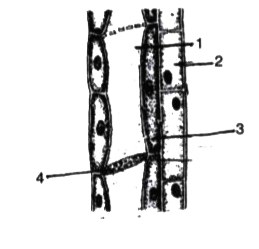
Name the parts labelled 1,2,3 and 4.
View SolutionStudy the diagram given below and then answer the questions that follow :
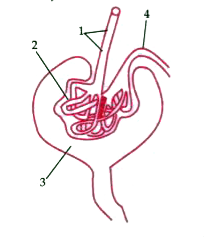
Name the stages involved in the formation of urine.
View SolutionGiven below is a set of five terms. Rewrite the terms in logical sequence as directed at the end of each statement,
Renal vein, Renal artery. Afferent arteriole, Efferent arteriole, Glomerulus (Pathway of blood through glomerulus).
View SolutionThe diagram below shows the Excretory System of a Human being. Study the same and then answer the questions that follow :

Name the endocrine gland which could be added in the diagram and state its location/ position.
View SolutionDifferentiate between the following pair on the basis of what is mentioned within brackets:
Bowman's capsule and Malpighian capsule (Parts included)
View SolutionDifferentiate between the following pair on the basis of what is mentioned within brackets:
Renal cortex and Renal medulla [Parts of the nephrons present]
View SolutionDifferentiate between the following pair on the basis of what is mentioned within brackets:
Ureter and Urethra [function]
View SolutionGive biological reason for the following:
The renal cortex has a dotted appearance.
View SolutionGive biological reason for the following:
There is frequent urination in winter than in summer.
View SolutionThe given diagram represents a nephron and its blood supply. Study the diagram and answer the question :

State the reason for the high hydrostatic pressure in the glomerulus.
View SolutionThe given diagram represents a nephron and its blood supply. Study the diagram and answer the question :
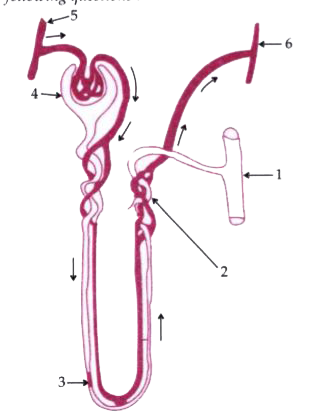
Name the blood vessel which contains the least amount of urea in this diagram.
View SolutionThe given diagram represents a nephron and its blood supply. Study the diagram and answer the following questions:

Name the two main stages of urine formation.
View SolutionThe given diagram represents a nephron and its blood supply. Study the diagram and answer the following questions:

Name the part of the nephron which lies in the renal medulla.
View SolutionThe diagram given below shows a section of a human kidney. Study the diagram carefully and answer the questions that follow :
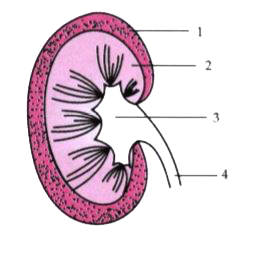
Label the parts numbered 1 to 4.
View SolutionGiven below is a simple diagram of the human kidney cut open longitudinally. Answer the following questions :

Name the structural and functional units of the kidney.
View SolutionChoose the correct answer from the given four options.
(i) The nephrons discharge their urine at the:
1)Urinary bladder
2)Urethra
3)Renal pelvis
4)Renal pyramid
View SolutionComplete the following paragraph by filling in the blanks (1) to (V) with appropriate words:
The amount of urine output is under the regulation of a hormone called (i)___________ secreted by the (ii)__________lobe of the pituitary gland. If this hormone secretion is reduced, there is an increased production of urine. This disorder is called (iii)__________ . Sometimes excess glucose is passed with urine due to hyposecretion of another hormone called (iv) __________ leading to the cause of a disease called (v)__________
View SolutionWhat is the exact location of proximal convoluted tubule.
View SolutionChoose the ODD one out of the following terms given and name the CATEGORY to which the others belong :
Bile, Urea, Uric acid, Ammonia
View SolutionChoose the ODD one out of the following terms given and name the CATEGORY to which the others belong :
Urethra, uterus, urinary bladder, ureter.
View SolutionName & describe the Process of maintaining water and salt balance in the blood.
View SolutionCorrect and rewrite the statement by changing the biological term that is underlined for each statement: The kidney is composed of number of neurons.
View SolutionThe diagram given below represents an organ system in the human body. Study the same and answer the questions that follow:
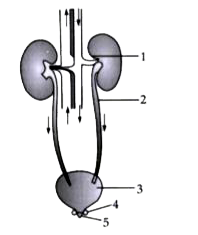
Identify the system.
View SolutionThe diagram given below represents an organ system in the human body. Study the same and answer the questions that follow:

Label the parts marked 2 and 4. Mention the function of part 5.
View SolutionThe diagram given below represents an organ system in the human body. Study the same and answer the questions that follow:

Name the structural and functional units of the part marked 1.
View SolutionThe diagram given below represents an organ system in the human body. Study the same and answer the questions that follow:

What is the fluid that accumulats in part 3?
Which is the main nitrogenous waste present in it?
View SolutionThe diagram given below represents an organ system in the human body. Study the same and answer the questions that follow:

Draw a neat, labelled diagram showing the longitudinal section of part 1.
View Solution
REVIEW QUESTIONS questions and complete solutions for chapter EXCRETORY SYSTEM of EVERGREEN BIOLOGY (ENGLISH) of Class 10